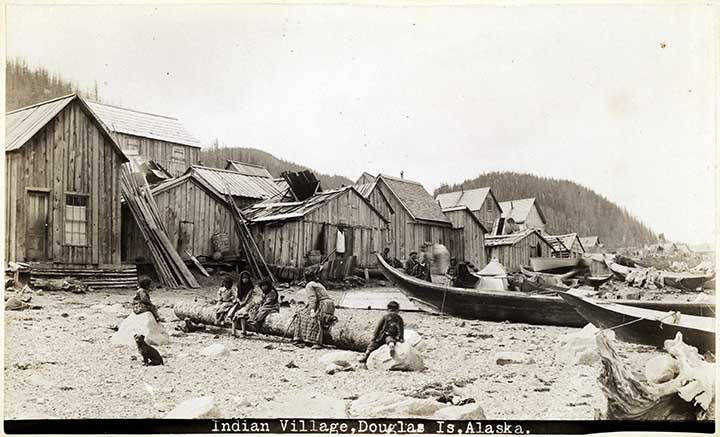Fifty-six years ago, the City of Douglas condemned, burned down and bulldozed Douglas Indian Village. The fire took 20 homes. It also took livelihoods.
At the annual conference of the Alaska Historical Society, held at the end of September at the Father Andrew P. Kashevaroff Library, Archives and Museum Building, historians, teachers and those affected by the village’s destruction gathered to discuss both how to address it and heal from it.
Participants were University of Alaska Southeast anthropologist Daniel Monteith, Tlingit scholar Norma Shorty from Teslin, Yukon, Dionne Cadiente-Laiti of Goldbelt Heritage Foundation, Douglas Indian Association tribal council treasurer and Native Student Success Coordinator at the Juneau School District Barbara Cadiente-Nelson, elder and Thunderbird Clan leader David Katzeek, Lillian Petershoare of the Yanyedi clan, elder Paul Marks, and Liana Wallace of the Alaska State Museum.
“We have to do an inventory of those things that occurred to hurt us (for healing),” Katzeek said. “And the next step is we need to be able to let it go, forgive, and move on. Because if we hold on to our resentments and anger, it will kill us faster than anything.”
Katzeek spoke of a memory from his childhood, a meeting in which Tlingit residents of Juneau were asked to recall how many times they landed their canoe at a particular location in order to establish whether or not they had claim to it.
“If you saw your own family’s land being taken from you and then being burned up, and then being talked to as if they were stupid people… Can you feel the hurt that I’m expressing?” he asked, becoming emotional, as many of those participating in the discussion did. “It makes you feel like you’re nothing. It makes you feel like you’re nobody. It makes you feel worthless. (But) I would rather feel what I feel than to be high on the highest drug or be drunk as I could be, because this is being human.”
The Douglas Indian Village was the winter village of the Taku Kwáan. The city condemned and destroyed it in 1962 so it could build the Douglas Harbor. The harbor was initially stemming from a 1946 Douglas Indian Association request: the village needed a harbor in order for its residents to be eligible for boat loans. Though initial plans were to rebuild the village, that never happened, and when the village was burned, so were the contents of the homes, including nets used for fishing. That’s something panelists said is directly linked to the decline of fishing as an occupation among the Taku Kwáan. In other words, the negative, and palpable, effects of the village’s destruction continue to this day.
Andrew Huff of the Indian Law Resource Center in Montana in 2002 authored a report investigating the village’s destruction. He found, in part, that the Bureau of Indian Affairs “abandoned its legal duty to protect the rights of the Native occupants of the Village,” potentially because two BIA employees were also on the Douglas planning and zoning commission, and recommended steps for the city of Juneau and the BIA to take to both investigate and remedy the wrong.
With the report, an award-winning story from KTOO last year, and more acknowledgment in general, the village’s existence, and its destruction, is becoming more widely known, though the report’s recommendations have yet to be followed.
Part of what can be done to heal is ensuring education history is more holistic, taking into account indigenous truths, Monteith said.
Ensuring the voices of indigenous people in history “is all of our responsibility,” Shorty said. “It’s not just ours. We are inviting you to help us.” One way to do that, she said, is to invite an indigenous response if, for example, a history book denigrates indigenous people.
Even the discussion itself is a step toward that. It’s the first time he’s aware of, Monteith said, for a conversation like this at the conference.
“On Lingít aaní (Tlingit land)… this is decolonializing the (discussion) hopefully a little bit, or at least stepping towards it,” he said.
Cadiente-Laiti spoke about two healing totem poles that will soon be carved — one for Gastineau School, where Tlingit graves have been unearthed, and the other at the former site of the Douglas Indian Village. The totem poles won’t resolve anything, she said, but they are at least a form of documentation.
“What can you do?” Cadiente-Laiti asked of historians. “Just knowing that this history is alive to us. There’s a trauma that goes with it, and your voices in helping us share that is tremendous. This meeting is momentous, because for years, this has just gone almost as if this village was never there.”
To read Huff’s report, go to http://tinyurl.com/hl26gcy.
• Contact Capital City Weekly editor Mary Catharine Martin at maryc.martin@capweek.com.
Read more Capital City Weekly:
Traversing the Northwest Passage: Juneau man makes fabled journey
On Writing: Still harping, Part II
Conceptual design out for new Juneau arts complex

